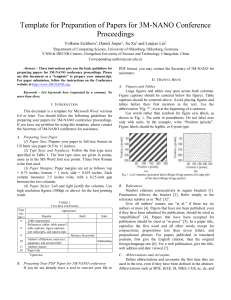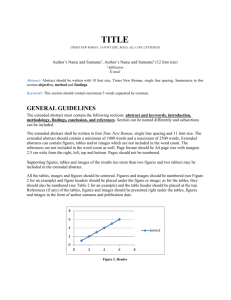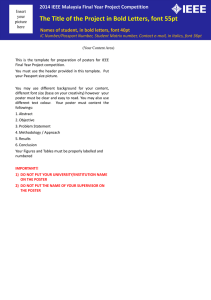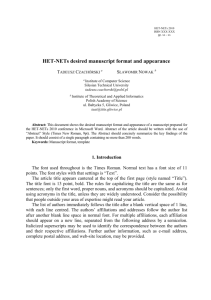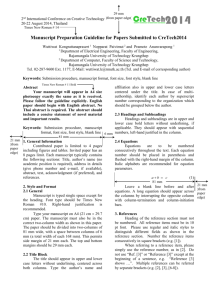MEASUREMENT OF SIGNAL STRENGTH IN CDMA BY
advertisement
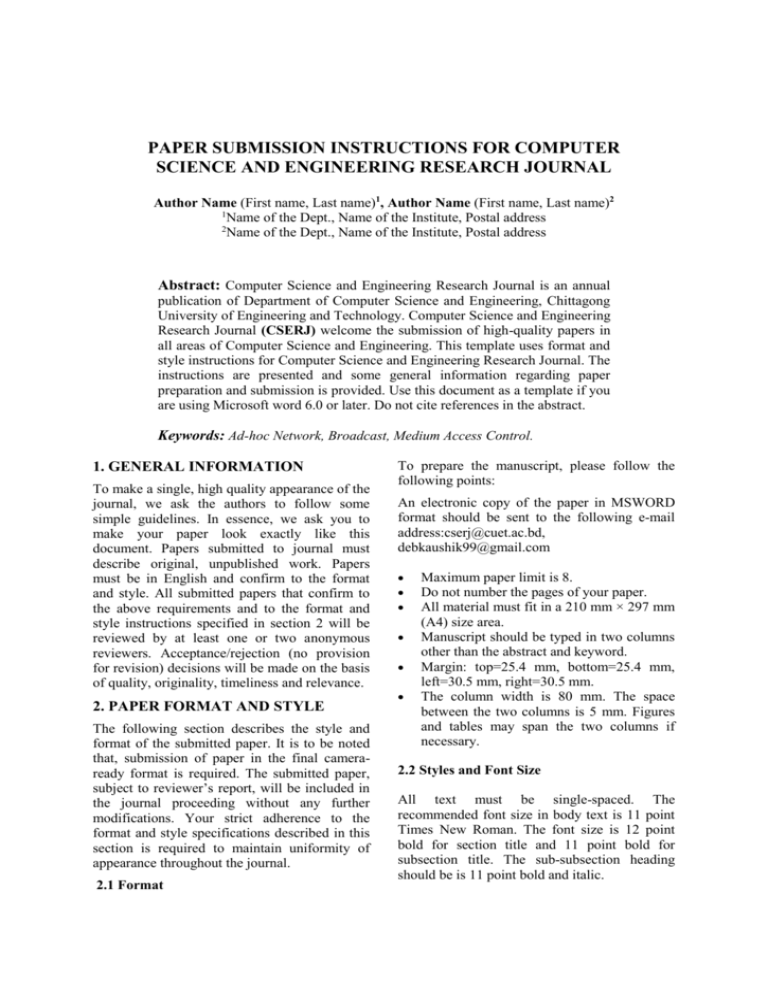
PAPER SUBMISSION INSTRUCTIONS FOR COMPUTER SCIENCE AND ENGINEERING RESEARCH JOURNAL Author Name (First name, Last name)1, Author Name (First name, Last name)2 1 Name of the Dept., Name of the Institute, Postal address 2 Name of the Dept., Name of the Institute, Postal address Abstract: Computer Science and Engineering Research Journal is an annual publication of Department of Computer Science and Engineering, Chittagong University of Engineering and Technology. Computer Science and Engineering Research Journal (CSERJ) welcome the submission of high-quality papers in all areas of Computer Science and Engineering. This template uses format and style instructions for Computer Science and Engineering Research Journal. The instructions are presented and some general information regarding paper preparation and submission is provided. Use this document as a template if you are using Microsoft word 6.0 or later. Do not cite references in the abstract. Keywords: Ad-hoc Network, Broadcast, Medium Access Control. 1. GENERAL INFORMATION To make a single, high quality appearance of the journal, we ask the authors to follow some simple guidelines. In essence, we ask you to make your paper look exactly like this document. Papers submitted to journal must describe original, unpublished work. Papers must be in English and confirm to the format and style. All submitted papers that confirm to the above requirements and to the format and style instructions specified in section 2 will be reviewed by at least one or two anonymous reviewers. Acceptance/rejection (no provision for revision) decisions will be made on the basis of quality, originality, timeliness and relevance. 2. PAPER FORMAT AND STYLE The following section describes the style and format of the submitted paper. It is to be noted that, submission of paper in the final cameraready format is required. The submitted paper, subject to reviewer’s report, will be included in the journal proceeding without any further modifications. Your strict adherence to the format and style specifications described in this section is required to maintain uniformity of appearance throughout the journal. 2.1 Format To prepare the manuscript, please follow the following points: An electronic copy of the paper in MSWORD format should be sent to the following e-mail address:cserj@cuet.ac.bd, debkaushik99@gmail.com Maximum paper limit is 8. Do not number the pages of your paper. All material must fit in a 210 mm × 297 mm (A4) size area. Manuscript should be typed in two columns other than the abstract and keyword. Margin: top=25.4 mm, bottom=25.4 mm, left=30.5 mm, right=30.5 mm. The column width is 80 mm. The space between the two columns is 5 mm. Figures and tables may span the two columns if necessary. 2.2 Styles and Font Size All text must be single-spaced. The recommended font size in body text is 11 point Times New Roman. The font size is 12 point bold for section title and 11 point bold for subsection title. The sub-subsection heading should be is 11 point bold and italic. Computer Science and Engineering Research Journal 2.2.1 Title and Authors 5. FIGURES AND TABLES The paper title is to appear in boldface capital letters, centered across the top of the column on the first page. The recommended font size for the paper title is 14 point. The recommended font is Times New Roman. The name(s) of the author(s) should appear below the title in boldface uppercase and lowercase letters (e.g. Md. Tajul Islam). The affiliation(s), and address(es) should appear below the author(s) name. The font size for author(s) name, affiliation(s) and address(es) is 12 point Times New Roman font and centered. 2.2.2 Abstract The paper Abstract appears below the title area on the first page as the first item on the whole column. Abstracts should be typed in single column having 30 mm from both sides. Not more than 200 words. Abstract should includes the objective, methodology used, results and conclusions. 3. HEADINGS AND SUB-HEADING All figures and tables must be referred to in the paper. They must be numbered and have captions. An example is Fig. 1 and Table 1. Table 1 Types of image processing in the extended lossy DCT-based mode. Image Bits per Entropy display sample coding Sequential 8 Huffman Progressive 8 Huffman sequential Progressive 12 Arithmetic spectral Figures and tables should be of high quality and placed at the top of the respective page if possible. Large figures and tables may span both columns. Color and halftone illustrations must be such that they are acceptable when printed in black and white. Placement of figures and tables should normally be after their first citation in the text. Major headings should be numbered and appear in boldface capital letters, left aligned within the respective column. Secondary headings (Subheading) should be numbered, left aligned in the respective column and in boldface letters with combination of uppercase and lowercase. Tertiary heading (Sub-subheadings) should be left aligned in the respective column and in boldface italic letters. 4. MATH OR EQUATIONS Use Microsoft Equation Editor for equations in your paper. Number equations consecutively with equation numbers in parentheses flush with the right margin, as in (1). Use parentheses to avoid ambiguities in denominators. Punctuate equations when they are part of a sentence, as in f x 1 2 log10 1 2 x 3 (1) Equations should be left aligned. Be sure that the symbols in your equation have been defined before the equation appears or immediately following. Fig. 1 Logo of Chittagong Univ. of Engg. and Tech. Place figure captions below the figure; place table titles above the tables. If your figure has two part, include the labels “(a)” and “(b)” as part of the artwork. Please verify that the figures and tables you mention in the text actually exist. The figure captions and title of the table should be bold and start with capital followed by the small letters and left aligned. Computer Science and Engineering Research Journal 6. ABBREVIATIONS AND ACRONYMS support acknowledgements are placed in the unnumbered footnote on the first page. Define abbreviations and acronyms the first time they are used in the text, even after they have already been defined in the abstract. Abbreviations such as IES, SI, AC and DC do not have to be defined. Abbreviations that incorporate periods should not have spaces: write “C.N.R.S.,” not “C. N. R. S.” Do not use abbreviations in the title unless they are unavoidable. REFERENCES 7. CONCLUSION A conclusion section is not required. Although a conclusion may review the main points of the paper, do not replicate the abstract as the conclusion. A conclusion might elaborate on the importance of the work or suggest applications and extensions. 8. APPENDIX Appendixes, if needed, appear before the acknowledgment. 9. ACKNOWLEDGEMENT The preferred spelling of the word “acknowledge” in American English is without an “e” after the “g”. Use the singular heading even if you have many acknowledgements. Avoid expressions such as “one of us (S.B.A.) would like to thank…” Instead, write “F. A. Author thanks….” Sponsor and financial References are numbered in order of appearance in the paper. Number citations consecutively in square brackets [1]. The sentence punctuation follows the brackets [2]. Multiple references are separated by comma and enclosed by square brackets [1, 3] Use 11-size font in listing the references. References are typed according to the following examples, journal articles, proceedings, reports, books, edited books, thesis and unpublished papers. 1. Last day of access (November 20, 2011). [Online]. Available: http://en. wikipedia.org/wiki/Android_operating_ system. 2. Foster I, Kesselman C., “Globus: A metacomputing infrastructure toolkit.”, International Journal of Supercomputer Applications 1997; 11(2):115–128. 3. Chung, R., Sundaram, D., and Srinivasan, A., “Integrated personal recommender systems”, In Proceedings of the ninth international conference on Electronic commerce (ICEC '07). ACM, New York, NY, USA, pp. 65-74, 2007. 4. Adomavicius, G., and Tuzhilin, A., “Context-Aware Recommender Systems”, Recommender Systems Handbook, pp. 217-253, 2011.
